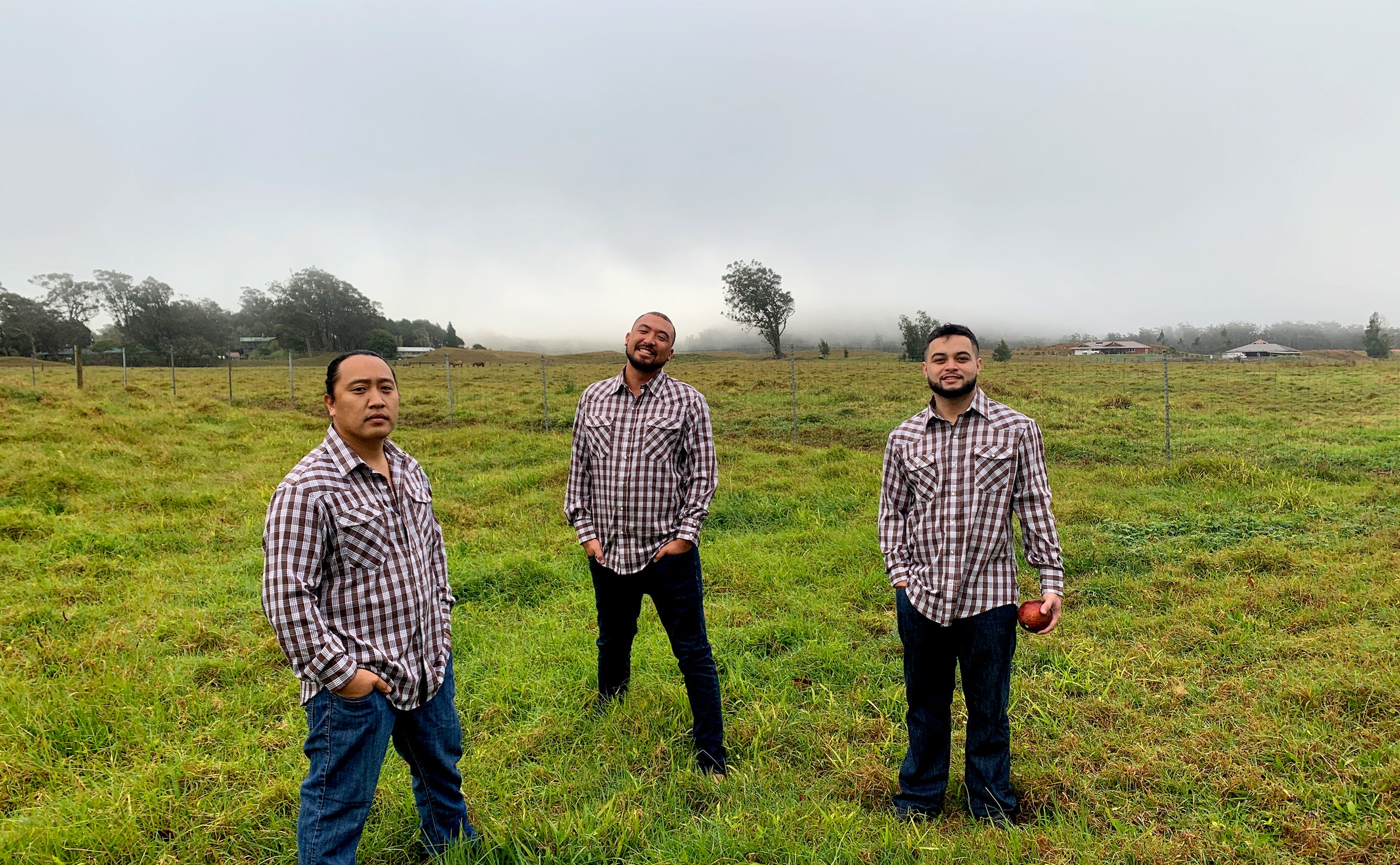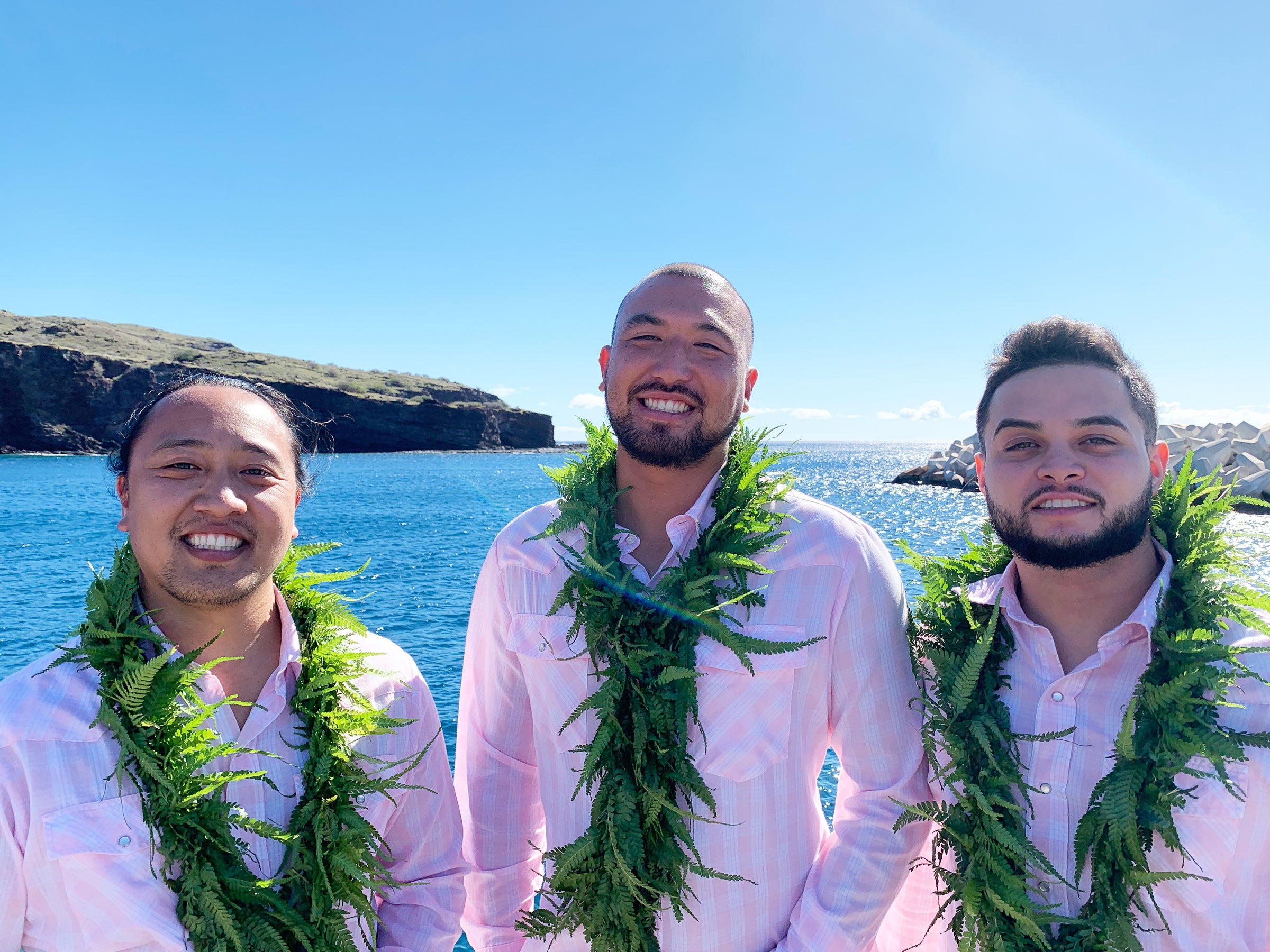EL NEI
O‘ahu
Band
Ei Nei is comprised of Dane Fujiwara (Wailuku), Grant Kono (Oneawa), and Ekolu Chang (Kāne`ohe). After having been on their own paths as musicians for some time with various accolades amongst the group, Ei Nei began their musical journey together in 2016. Together, they feature a smooth vocal blend with rich harmonies. Ei Nei offers you a refreshing glimpse into the traditional past with their sights set on the future of Hawaiian music.
Q&A WITH El Nei
Q: How did the three of you meet?
A: We knew of each other through mutual people in the music and hula community. Grant and Ekolu knew each other from their WCC days and through mutual friends from high school. Dane knew Grant from the Uncle Richard Leo Ki‘eki‘e Falsetto Contest and he knew Ekolu through Kanoe (Daneʻs wife) when she and Ekolu worked together during the summer.
Q: What made the three of you guys form a band together?
A: Dane just recently moved up to O‘ahu from Maui and there was an event that Grant got asked to play at. He said “can I bring some friends?” He and Ekolu were slated to play and Ekolu mentioned that Dane had just moved up and to see if he would be down to play. Dane said yes and that was the first time we played together. We played at another birthday party and realized making music together was easy and fun. Our “debut” performance as Ei Nei was at the 2017 Merrie Monarch Fundraiser for Hālau Hi‘iakaināmakalehua.
Q: What about yourselves do you think contributes to Ei Nei’s greatness?
A: I think that the biggest contributor to success is the pilina, the relationship, that we share amongst each other both on and off stage. If you canʻt laugh and have a good time backstage youʻll never have an enjoyable time on stage. The ultimate goal of our group is to embody Ei Nei between the three of us and our audience.
When it comes to music, I think that individually we come from various sources of knowledge and experiences. We didnʻt go to the same “classes” or we learned from the same people. We have a variety of experiences that allow us to be creative in ways that we learn from each other, experiment, and find ways to be unique and true to ourselves while also honoring those that have influenced and helped us to be where we are today.
Q: What is the story behind your band name?
A: Ekolu shares the joke that when we were asked to play for that fundraiser we needed a more formal name because _____ & friends wouldnʻt be good enough. We were looking for something like “just us” or “us 3 guys” and since Nā Hoa was already taken we settled on Ei Nei. And from those jovial beginnings, Ei Nei, has become almost like a standard for us to keep for a few reasons: 1) the term is synonymous with Aunty Lena Machado and her music. Thus we need to strive to present ourselves and our mele so that we can continue to be a bridge from yesteryear to the present. 2) This is kind of the high level academic answer but Ei Nei as defined is a term of endearment shared between people. As a tutu calls out for a mo‘opuna or in Aunty Lenaʻs case her specific designation for Uncle Lu, or just a reminder of how our Hawaiian society would converse each person has a unique idea to who would be considered their “Ei Nei.” Therefore, the challenge for us we have chosen that for ourselves we need to strive to embody and satisfy those unique personalized requirements in order to be who we are. And as mentioned earlier Ei Nei is the result of a two way relationship. Thus our name is an homage to our audience because without them we literally wouldnʻt exist (or make sense from a Hawaiian language standpoint).
Q: Why do you like creating and what is your creative process like?
A: We as Hawaiian musicians benefit a lot from Mele Hawai‘i. We get to experience a lot like travel the world, meet new people, play music, and also pay bills. Thus we take from that well to sustain us. I think that it is extremely important that we do what we can in order to replenish and give back to mele as best as we can. Thus creating new music is kind of like a kuleana because we need to offer our mahalo to the source that gives to us. In addition to that creating new music is a way we get to honor those that have influenced us along the way.
Hula is a big part of our music so we try to do as best as we can to provide mele that can be accompanied with hula. Mele and hula are two independent parts that combine to unite and lift each other. With that being said our creative process is probably best fit in the trial and error category. If one of us has an idea then we try it. If it works out then we keep it. If it doesnʻt work out we put it in timeout till the idea is ready to be worked out.
Q: What is in store for Ei Nei in the future?
A: We are trying to navigate this global situation as best as we can. Because concerts and many large gigs are still on pause our plan is to hit the studio and release more new music. We still feel that we havenʻt really gotten the fullest opportunity to share our debut album with the world so we hope that once the world is safe and at a comfortable place we will be ready to hit the road again.
Q: Can you tell us the story about how you met / became familiar with Paul & Western Aloha?
A: This is one of the coolest stories of our history as Ei Nei. We were just starting out and we were asked to travel to Hawai‘i island to play. As we board the plane and sit down the Hawaiian Airlines planes are 2 seats on one side and 3 seats on the other. Ekolu is the lone wolf in the three seater. In walks this guy wearing a palaka shirt. Grant makes a comment thatʻs a nice palaka shirt and his response was itʻs mine I made it. To us thatʻs not a common response when it comes to clothes. So we talk-story about Western Aloha, the Waimea roots and how Paul learned about the art of the Aloha shirt. He said he was just starting out and he was working on getting Western Aloha into retail stores. Our stories and journey kind of paralleled each other in two separate worlds. We swapped contacts and went our ways. A short time later we reached out to Paul to see if there was a possibility that we could wear some of his attire as we were set to play in Hilo at various Merrie Monarch events. He noted that he hadnʻt tested the musician and hula world yet. Paul was kind enough to gift us shirts for those performances. Thus the Alenuihaha shirt has become something we were known for. When we would gig in Western Aloha we would receive a lot of comments and inquiries about where we got the shirt. Ever since day 1 Paul and Western Aloha have been a big supporter of us and we wear our Western Aloha attire as often as we can. Anytime we have asked Paul has always been there for us. Youʻll find us in the Kaula’ili shirt at our Nā Hōkū Hanohano performance last year. If we travel to the countryside youʻll find us in one of our palakas. We can be found in the Koa shirt at hula competitions where comfort is key while not calling too much attention to ourselves and many times youʻll find us in white shorts and the Surfboard print.



